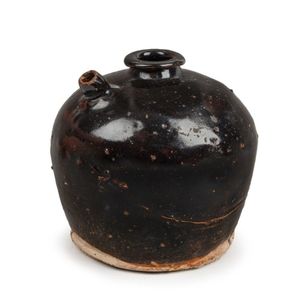
Antique Chinese Pottery Water Pot from Ballarat Goldfields, 19th Century
An antique Chinese pottery water pot, excavated from the Ballarat goldfields, mid 19th century, 12 cm high

Gem-Inset Copper Figure of Padmasambhava
A Nepalese Gem-Inset copper figure of Padmasambhava, 20th century, depicting Padmasambhava seated holding a vajra, water pot and trident, height 22 cm
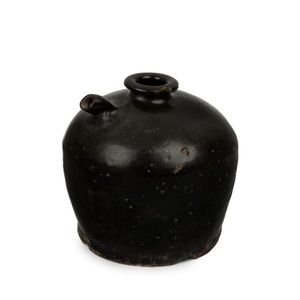
Chinese Pottery Water Pot from 19th Century Goldfields
A Chinese pottery water pot, dug from the goldfields of central Victoria, mid 19th century, a rare survivor, 13.5 cm high. Provenance: The Jules Feldman collection Melbourne

Chinese Enamelled Water Pot with Lotus and Bats Design
A Chinese enamelled water pot, Tongxi mark and of the period, decorated with scrolling lotus bats and shou characters in enamels against a blue enamel ground, six character Tongxi mark in iron red to base. Height 6.5 cm, diameter 8 cm,

Green Dragon Water Pot on Stand
Famille verte 'Dragon' covered water pot presented on a stand and hand painted in a green dragon motif. 12 cm

Blue Dragon Water Pot, Kangxi Period
An antique Chinese ceramic water pot with underglaze blue dragon decoration, Kangxi Period, circa 1700, 23 cm high, 19 cm wide

Copper-Red-Glazed 'Beehive' Water Pot
A copper-red-glazed 'Beehive' water pot Taibaizun, 18th-19th century the domed body is covered with a crushed strawberry-red glaze thinning to a pale greyish-pink tone on one side of the body and to a mushroom tone on the lipped rim, 12.2 cm diameter.…

Qing Dynasty Celadon Jade Water Pot with Chilong Carving
A small pale celadon jade water pot, Qing Dynasty (1644-1911) carved with a chilong clambering at the rim, the pale white stone with a few russut inclusions, 6 cm high. Provenance: Sotheby's, Hong Kong, 29/11/2019, lot 846 (part)

Bronze Kendi with Makara Head Spout
Indian bronze water pot (kendi), with makara head spout, height 17.5 cm

Red Sang de Boeuf Porcelain Water Pot, Chinese
Chinese sang de boeuf porcelain water pot, of domed form with a short waisted neck, in rich red tones, six character mark to base, height 10 cm and diameter 12 cm

Chinese Lion Motif Glazed Terracotta Water Pot
A tall Chinese glazed terracotta water pot, with applied lion motif, 60 x 44 dia cm

Set of Four Chinese Peach Glaze Porcelain Items
Four Chinese peach glaze porcelain items, including bottle form vase, smaller vase, circular brush washer and water pot, all in mottled red and green/ brown tones, blue double ring mark to bases, height 21.5 cm, 15.5 cm, 5 cm and 8.5 cm (4)
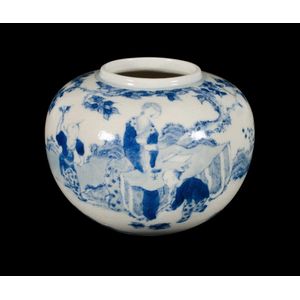
Qianlong Blue and White Water Pot with Scholars
Chinese blue and white soft paste Globose water pot - Qianlong 1736-1795). Decorated with scholar in a garden with two attendants. Ex Andrew Stuart-Robertson. Height 6.5 cm
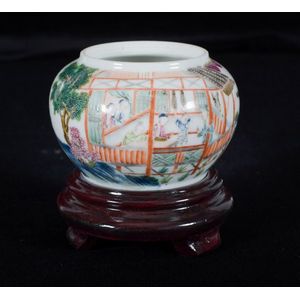
Famille Rose Chinese Porcelain Water Pot with Daoguang Mark
Chinese porcelain water pot. With famille rose overglazed decoration of figures in a house. Six lines of script verso. Bears iron red Daoguang mark to base. Height 5.5 cm

Blue and White Scholars Water Pot
Chinese soft paste scholars water pot. Decorated with underglaze blue rock, surrounded by flowers and bamboo. Ex Ray Tregaskis Oriental Art. Height 4.5 cm, Diameter 7 cm

Chinese Brown Glaze Porcelain Water Pot
Chinese brown glaze porcelain water pot, of domed formed with a short flaring neck, in mottled tones of brown and orange, height 8 cm

Celadon Jade Bird Waterpot
A celadon jade bird-form waterpot the figure standing facing forward, the wings and tail plumes with archaistic detailing, the hollowed body with a circular aperture in its back, the pale stone with some opaque mottling and faint russet striations 10 cm…

Guangxu Dragon Water Pot
A famille-rose 'dragon' water pot, Guangxu six-character iron red mark 14 cm diam, 9.5 cm high

Blue Glazed Chinese Porcelain Water Pot with Wave Motif
Chinese porcelain water pot, of squat domed form, the base decorated with raised turbulent wave motif, in pale blue glaze, mark to base, height 6 cm

Qianlong Blue Glazed Porcelain Water Pot
Chinese porcelain water pot, of elongated domed form, in a pale blue glaze, raised on a circular foot, marked with Qianlong mark to base, height 8 cm
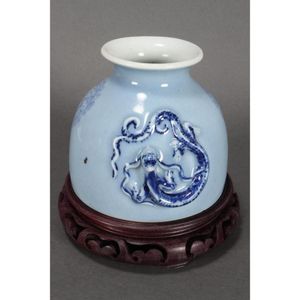
Qing Dynasty Dragon Water Pot
Chinese Qing Dynasty, Qianlong period porcelain water pot, accented with a raised dragon and three dragon roundels in cobalt on a clair-de-lune glaze, on a circular foot, with Kangxi six character mark to base, with ceramics Collectors Society exhibition…

Chinese Puce Porcelain Water Pot with Relief Figure Decoration
Chinese porcelain water pot, decorated in relief with figure seated under a tree, with incised script verso, in tones of puce, mark to base, height 6 cm

Famille Rose Water Pot with Crane Pattern - Qing Dynasty
A Chinese famille rose water pot with crane pattern (Qing Dynsty Guangxu mark), (, height 5.5 cm, depth 26 cm

Famille Rose Crane Water Pot
A Chinese famille rose water pot with crane pattern (Qing Dynsty Guangxu mark), height 3.5 cm, depth 14 cm

Tongzhi-marked Chinese water pot, 8cm height, 11cm diameter
A Chinese water pot bearing Tongzhi mark to the bases height 8 cm, Diameter 11 cm

Qing Dynasty Bamboo Goat Water Pot
A bamboo 'goat' water pot Qing Dynasty, carved in the form of a recumbent goat with legs tucked beneath its body and head turned over its back biting the stem of a lingzhi fungus, the hollow body with a small oval cover surmounted by a bat among cloud…

Chinese Carved Wood Writing Set with Fitted Box
Chinese carved wood writing set comprising two rulers, brush pot and water pot, in fitted box (4)

Chinese Crackle Glaze Porcelain Water Pot
Chinese crackle glaze porcelain water pot, of dome form, in pale tones, height 7.5 cm

Chinese Landscape Porcelain Cube Water Pot
Chinese scholars petit water pot, in porcelain, of cube form, decorated with roundels of landscapes, raised on four feet, seal mark to base, height 5 cm

Chinese Bell-Shaped Porcelain Water Pot with Mark (10cm)
Chinese sang De boeuf porcelain water pot, of bell form, six character mark to base, height 10 cm

Chinese Dragon Calligrapher's Water Pot, 20th Century
Chinese moulded and carved dragon calligrapher's water pot, early 20th century. Height 8 cm

19th Century Chinese Sang de Boeuf Water Pot
Chinese Sacrificial red or sang de boeuf water pot, 19th century. Diameter 9.5 cm. Provenance: Property of Peter Elder BA (Hons) (ANU), PhD (NTU). Collected around the 1970s

Indian Woman Carrying Water Pot Ivory Carving
An Indian ivory carving of a woman carrying a water pot on her head, raised on teak stand. Overall height 17 cm.

Celadon Jade Mythical Animal Water Pot, Qing Dynasty
A carved celadon jade 'mythical animal' water pot, Qing dynasty, 19th century, the animal striding forward with head turned back towards the removable stopper with pierced chilong knop, the haunches with stylised scrolls in low relief, the pale stone with…

Chinese Douchai Water Pot with Stand (9.3cm)
A Chinese Douchai water pot with stand, height 9.3 cm (without stand)

Peach Bloom Porcelain Water Pot with Stand & Box
A peach bloom porcelain water pot with stand with fitted box, height 4.6 cm (without stand)

Carved Wooden Huang Yang Water Pot with Pine Trees
An old Chinese Huang Yang water pot carved in wood, decorated with two very detailled pine trees, 8 cm x 6.5 cm x 4 cm

Chinese Qing Dynasty Porcelain Water Pot with Calligraphy Glaze
A Chinese porcelain water pot, the beehive shape with moulded decoration, late Qing Dynasty, calligraphy on the reverse of the monochrome glaze, diameter 6.5 cm. Provenance: The Estate of the late June Fairall

Qing Dynasty Water Pot with Carved Decoration
A water pot with carved and applied decoration, impressed mark to base, Qing Dynasty 19th century. Wang Bingrong, diameter 7 cm. Provenance: The Estate of the late June Fairall

Chinese Glazed Water Pot with White Interior
Chinese sang de Beouf glazed water pot, of dome form, in rich glaze with white interior, raised upon circular foot, with six character mark to base, height 9 cm

Celadon Jade Pomegranate Waterpot with Boy and Foliage
A celadon jade 'pomegranate' waterpot Qing dynasty, (2), the large hollowed fruit growing on a branch bearing further fruit and foliage extending in pierced relief over the sides, a small boy seated clinging to the branches, the stone of pale even tone,…

Qianlong Marked Chinese Porcelain Water Pot with Fine Painting
A Chinese porcelain water pot with very finely painted figures in overglaze, Qianlong mark, a band of waves in underglaze blue around the foot, height 10, diameter 15 cm

Chinese Porcelain Water Pot with Figure and Crane Decoration
A Chinese porcelain water pot decorated with painted figures and crane with six character mark to base, height: 7.8 cm, diameter 10 cm
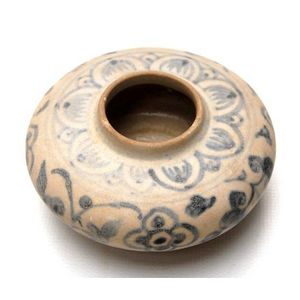
Ming Dynasty Chinese Porcelain Water Pot
A Chinese porcelain water pot, Ming Dynasty. Provenance: The private collection of an Eastern suburbs gentleman. Height 4 cm. Diameter 9 cm

Chinese Guangxu Water Pot with Apple Shape
A Chinese apple-shaped water pot, Guangxu mark to base, 20th century, designed as ornamental and functional for the scholar's table, a channel around the short neck for dripping water, a good even glaze, D 9 cm, height 7.5 cm

Gilded Chinese Porcelain Water Pot with Dragon Design
Fine Chinese porcelain water pot Guangxu mark gilded with pair of rust dragons chasing the flaming pearl reign mark to base 9.6 cm x 6.5 cm

Red Beehive Water Pot with Crackled Base
A Chinese water pot, in a beehive shape, the red glaze fired out, a controlled pooling in parts on foot rim, cream crackle glazed base with double rings. Height 10 cm

Kangxi Peachbloom Glaze Waterpot, 12.5 cm Diameter
A Chinese peachbloom-glaze waterpot, Kangxi six-character underglaze blue mark and of the period, 12.5 cm diam

Qing Dynasty Peach Bloom Glaze Water Pot
Chinese peach bloom glaze water pot. Qing Dynasty, with blue double circle mark to base. Height 6 cm

16th Century Chinese Blue and White Duck Water Pot
A Chinese blue and white covered water pot, in the form of two mandarin ducks, 16th century, 9 cm high and 12 cm long. Provenance: Rustam, Ujung Pandang, late 1960's

Crackle Turquoise Brush Washer & Bronze Water Pot
A Chinese leaf shaped brush washer with crackle turquoise glaze together with a water pot, imitating a bronze shape, with purple splash to side [2] length 14 cm & diameter 13 cm

Ming Dynasty Water Pot with Floral Decor
Blue and white water pot Ming Dynasty decorated with flowers and Chinese characters. Height 10 cm

Celadon Jade Lotus Washer and Jadeite Waterpot
A celadon jade 'lotus' washer Qing dynasty in the form of a lotus leaf with incurled edges, a frog crouched on the interior, and a flower in relief on one side, the pale stone with areas of russet suffusions, wood stand; together with a later jadeite…

Famille Rose Beehive Water Pot with Bird and Flower Design
A small Chinese porcelain water pot, beehive shape, decorated in famille rose enamels with birds and flowers, six character mark under the base. Diameter 6.5 cm

Kangxi Peachbloom Beehive Water Pot
Chinese peachbloom beehive water pot Taibaizun Kangxi mark of beehive form with small flared mouth, the body covered with mottled crackled peachbloom glaze, base with six character Kangxi mark, measures 13.2 cm diam, 10 cm high

Cantonese Enamel Calligrapher's Water Pot and Spoon
A Cantonese enamel Calligraphers, brush washer water pot and spoon decorated with floral motifs and with character marks to base. Height 4.8 cm

Chinese Kangxi Dragon Beehive Water Pot
A Chinese carved white-glaze ' kui -dragon' beehive water pot, Kangxi six-character underglaze blue mark 9 cm high. Provenance: Private collection Victoria

Chinese Celadon Water Pot with Bird Spout
A Chinese deep celadon green glaze Khendi style water pot with birds head spout. Height 21 cm

Chinese Blanc de Chine Water Pot with Lug Handles
A Chinese blanc de Chine water pot with two lug handles. Length 15 cm

Celadon Floral Water Pot, 10cm Height
Celadon water pot, with incised floral decoration, one small firing flaw to spout. Height 10 cm

Antique Chinese Peachbloom Glazed Waterpot
Chinese peachbloom glazed beehive waterpot, 19th century, apocryphal six-character Kangxi mark to the base. Diameter 10.5 cm. Provenance: Dr. John A. and Louise Gray 'Mark and Period' Collection.

Chinese Republic Vases and Water Jug Set
Two Chinese Republic vases one bright yellow, the other brown. Vases, 28 cm, 19 cm, each globular form with cylindrical neck, together with a under glaze blue vase and a water pot with fluted handle. Water jug. 23 cm high.

Robins Egg Glazed Chinese Peach Water Pot
A Chinese water pot, modelled as a peach on four bracket feet with robins egg type glaze, probably late Qing Dynasty, 6 cm high


 Loading more...
Loading more...